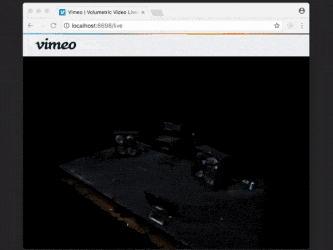This repository consists of tools and demos presetned at the Volumetric Filmmaking meetup at NYC.
Watch the livestream from the meetup or check out the depth viewer repository.
- Requires a Vimeo Pro account or higher.
- Node.js


Make sure you check out the requirements before starting.
First you'll need a video to test with on your Vimeo account. You can download one of the following demo videos:
Upload them into your Vimeo account. Copy the description of the video on Vimeo as well - it's our hacky way of storing JSON config information.
Note: In order to stream Vimeo videos, you will need direct video file access via the Vimeo API. Accessing video files via API is limited to Vimeo Pro and Business customers.
If you're unfamiliar with setting up Node, the easiest way to get started is to just remix our demos on Glitch (click the GIFs above).
- Click here to Remix the demo on Glitch
- We will need to use the Vimeo API so that we can grab the video files directly for WebGL to use. To make your life easy, we made this handy link which will generate the token for you. Once you have authorized the app, it will give you a token so you can paste into the
.envfile. If you're running this locally, create a.envfile in your root folder. Your.envfile should now look something like this:
VIMEO_TOKEN=406cea4d4xxxxxxxxxxe437756d036f5
- In the examples folder swap your volumetric Vimeo video id with the one provided in the
examples/demo.html
depthPlayer = new Vimeo.DepthPlayer('YOUR_VIDEO_ID');- Download or clone the repository,
git clone /~https://github.com/vimeo/vimeo-depth-player.git - Generate a token for your Vimeo account here and save the token into a
.envfile in the root folder of the repository.
VIMEO_TOKEN=asfa733240239qwerfhuasf- Install all dependencies by running
npm installinside the repository folder - Run the server,
npm run start - In the examples folder swap your volumetric Vimeo video id with the one provided in the
examples/demo.html
depthPlayer = new Vimeo.DepthPlayer('YOUR_VIDEO_ID');examples/demo.html- A simple volumetric demo that also includes a background 3D model.examples/live.html- Almost identical todemo.htmljust different assets. We included this just to show what we used in our livestreaming volumetric demo.examples/resolution.html- This shows you how to select different video resolutions for playback.
- Supports DepthKit volumetric video hosted on Vimeo.
- Supports adaptive video (HLS/DASH) for fast video delivery and rendering (on supported browsers and mobile devices).
- Leverage our Depth Viewer to livestream volumetric video (color-depth) using Vimeo Live
- Supports streams captured with an Intel RealSense D415/D435
All the functionality is acsseable after instancing a Vimeo DepthPlayer in the following way
var depthPlayer = new Vimeo.DepthPlayer('YOUR_VIDEO_ID');Here is a list of all the parameters you can provide to the Vimeo.DepthPlayer() constructor:
Vimeo.DepthPlayer(
_vimeoVideoId, // (required) - The first parameter must be provided and describes the Vimeo video ID
_videoQuality, // Default is `auto` which will try to establish an adaptive stream, you can specifiy a fixed width by providing a number instead.
_depthType, // An enum desciring the depth encoding type. Currently you can choose between `Vimeo.DepthType.DepthKit` or `Vimeo.DepthType.RealSense`.
_depthStyle, // An enum desciring the depth rendering style. Default is `Vimeo.RenderStyle.Points`. Optionally you can use `Vimeo.RenderStyle.Mesh` or `Vimeo.RenderStyle.Wire`.
);play()- Play the volumetric videostop()- Pause playback and set the video time to 0pause()- Pause playbacksetVolume(volume)- Set the volume of the audiosetLoop(state)- Controls the loop statesetPointSize(size)- If renderingVimeo.RenderStyle.Pointscontrols the size of the pointssetOpacity(opacity)- Control the opacity of the 3D objectsetLineWidth(width)- If renderingVimeo.RenderStyle.Wirecontrols the width of the wireframedispose()- Get rid of thedepthPlayerinstance and clean up all resources
For questions and support, ask on StackOverflow. If you found a bug, please file a GitHub issue.
Make pull requests, file bug reports, and make feature requests via a GitHub issue.
Working on a cool video project? Let's talk!
Special thanks to three.js, DepthKit and DepthKit.js


